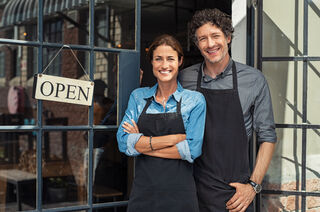Openness
How Do You Get That Special Person to Open Up to You?
Learn to influence with your mindful openness .
Posted February 24, 2022 Reviewed by Vanessa Lancaster
Key points
- Everything we want from each other, caring, understanding, collaboration, planning, and problem-solving, happen or don’t, depending on openness.
- You have the ability at each moment to influence the openness of the other person.
- Your steady, open contact sends a powerful message that you’re offering love and safety.

I’m often asked, “How do I get my boyfriend/ girlfriend/ husband/ wife/ lover/ friend/colleague to open up to me?”
At the heart of every encounter between two people is the question of open or closed. You meet with your colleague to discuss the curriculum for a course you're teaching together; you need them to be open to that great new idea you had last night. You're having dinner with your partner and talking about a possible vacation; you need them to be open to hearing your nervousness about flying. Your new love interest shows up late, again, for your date; you need them to be open to hearing that this upsets you.
We want and need a lot from other people: caring, understanding, collaboration, planning, and problem-solving. All of these happen or don’t, depending on openness. Behind the scenes of every encounter, we are constantly trying to solve the riddle: how do I get you to be more open to me?
The openness we’re looking for is an openness of heart and mind. Open, we're able to hear what the other person says with curiosity, compassion, and a minimum of judgment and rejection. When two people are open in conversation, they explore together in a way that includes as much of each of them as possible. When the conversation becomes about right or wrong, agreeing or disagreeing, winning or losing–openness has been lost.
We all have the ability to influence the openness of the other person in each moment.
At Each Moment
The openness between two people is a dynamic, constantly changing phenomenon. Too often, we limit ourselves and others by ascribing fixed characteristics as if we are always a particular way. When we think of the other person as being, in general, open or closed, we can fail to understand that this openness is constantly varying. The opportunity to influence toward openness happens in each unfolding moment.
Our Influence
Out of our extreme reliance on other human beings–for everything from companionship to child care to keeping the lights on–comes one of the worst enemies of our relationships: the desire to control each other. We do have the ability to influence each other powerfully; we do not have the ability to control each other. As soon as this is glimpsed, everything gets easier.
Your Openness Is the Most Powerful Influence
Openness happens when we feel safe. And it turns out that contact with other human beings can feel both very desirable and scary. The feeling of unsafety can be as large as your heart racing when someone gets angry and is yelling at you. Still, it can also be as small as that fluttery feeling in your stomach just before giving a presentation or entering a social gathering of strangers.
Our limbic system, a specialized part of the brain that processes emotions, memory, and safety, always monitors for any sign of danger. And when it comes to assessing the safety or danger of contact with other people, our limbic system is especially good at detecting and responding to the feelings and intent of another person. The same system that makes sure we are not going to get eaten signals us of the emotional equivalent of that when a friendly face suddenly darkens.
This brings us to the question of what you can do to help the other person be open to you. We're very responsive to our sense of another person’s openness or closedness. We tend to open when we are with others who are open and close when we are with someone who is closed. Neuroscientists call this “limbic resonance” (Lewis et al., 2000). So what is the most powerful thing you can do, at the moment, to influence toward openness? Open.
The Hard Part: Getting Yourself to Be Open
And now we come to the really sticky question: how do you get yourself to be open? Especially when someone is not so open to you. This limbic resonance is, after all, a two-way street. Just as your openness may influence them to be open, their closedness will exert a pull on you to close. How do you resist the temptation to follow their limbic system downward to closed?
Three Things Will Help You to Be Open:
- Present moment awareness of your openness.
- Risk-taking and generosity.
- Discipline (staying connected to what you really want).
Present Moment Awareness
The most important thing you can do is stay aware of the present moment–also known as mindfulness. Specifically, what you need to be most aware of is your openness. And by the way, it is much easier to notice the other person’s defensiveness closedness than to notice our own.
When you feel frustrated by the other person not quite being open, this should cue you to check in with your openness. Is it possible that without knowing it, you’re not quite open? It’s so easy, without even noticing, to be self-protective as we try to interact.
Learn to tune into your sense of being open or closed. The feeling of openness is a feeling of safety, relaxation, trust, optimism, and expansiveness. Being closed is the feeling of being wary, pessimistic, anxious, uncomfortable, and unsafe. Some people register these sensations as physical sensations. A feeling of tightness, hardness, or coldness anywhere in your body, but especially in your chest or belly, is likely to be a sign of being closed.
Feelings of looseness, softness, and warmth often signal openness. When we are open, new ideas are interesting and exciting instead of threatening. When we are open, we are less judgmental less prone to defensiveness; it is easier to be empathetic and compassionate.
Risk-Taking and Generosity
We want connection, but we also are very concerned about being hurt or disappointed. Wanting risk-free intimacy is a non-starter. Building relationships inevitably involves taking risks and, at times, being hurt. It’s risky to open your heart before the other person does. But when the other person is having trouble getting open, and you have the ability to drop your guard and go first, you influence both of you toward the possibility of connection.
Remembering What You Want
How do you find the courage and generosity to do these things? A friend of mine once said, “Discipline is remembering what you want.” Building trust, collaboration, and caring require being connected enough to want this in your relationships that you become capable of leading the way.
Are there any of us who don’t know the outcome of maximizing self-protection? Haven’t we already done that experiment a million times? Do the right experiment; find a way to be open.
It Might Look Like This
So, what happens in this dynamic dance of opening and closing as you interact? It might go like this. You’re open, and you attempt to tell your partner, vulnerably, what it is you are feeling. Maybe you got hurt when they recently forgot your birthday. You want them to respond with openness, something warm and sincere like, “Oh no. You’re right. I totally missed that. I’m so sorry. Let’s plan an evening together so I can try again.” Wonderful! Right? But it’s very possible that, instead, they may get defensive and close down. So instead, you get something like, “Are you kidding me!? After all, I did for you recently when your mother was here. You’re finding the one thing I messed up?”
They close, slam the emotional door, and you feel a strong pull toward closing in response. If you do, what happens next will be disappointment and injury for both of you. But what if, instead, you resist the pull and stay open? Maybe, after a moment to collect yourself, you respond with, “Wow, I totally get that. And you’re right. You were splendid during my mother’s visit. We had a great time. I’m not even sure that I told you how much that meant to me.”
This is the moment of real influence. The ability to stay steady, maintain contact, and stay open sends a powerful message that you’re offering love and safety. Your partner may then respond with softening and opening. Or, even if that doesn’t happen instantly, you have set the stage for the next set of moments between you, influencing things in the direction of trust and openness. This is the way to exercise leadership in the relationship, helping both of you create more chances for a caring connection.
References
Lewis, Thomas, Fari Amini, and Richard Lannon. A General Theory of Love. New York: Random House, 2000.




